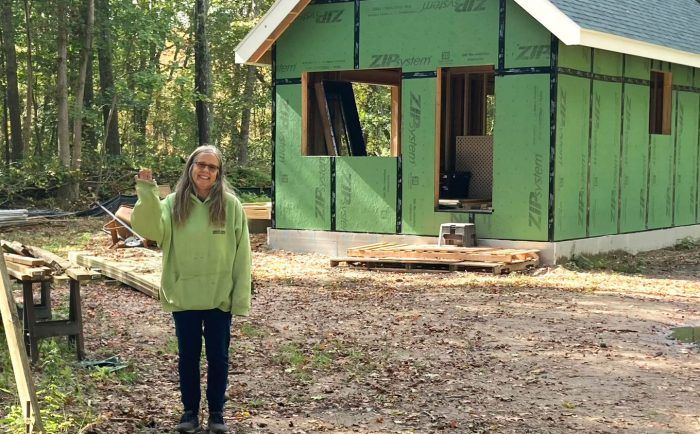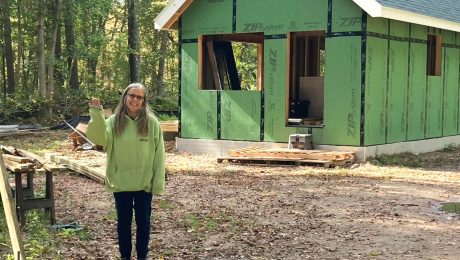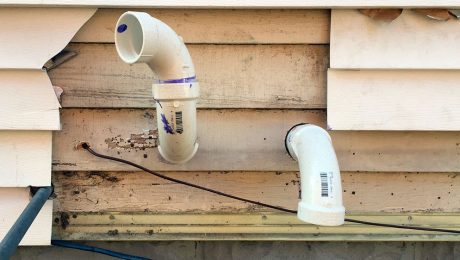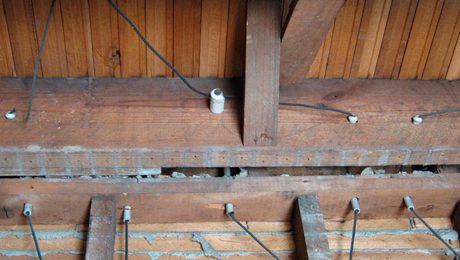Building Confidence, Community, and Inclusive Trades
Carpenter Kerri Gaffett reflects on tackling tradework independently and learning how to work with the physics of your body.

I wasn’t planning on being a carpenter, but I needed to make money to pay for college and my boyfriend (soon-to-be husband) needed a laborer and an introduction to the tricky ins and outs of living in a small community. It was a win-win situation—I knew all the people on the small island where I was raised and he knew how to build and needed an extra hand.
I loved working with my hands, working outside, and creating homes. We built a successful construction company and worked side by side for over 25 years. We had a sizable crew and amazing opportunities to build impressive homes for people seeking peace and quiet.
I wasn’t planning on flying solo in my 40s, but that is how my life unfolded. My was-band and I parted ways in 2015 after 27 years of marriage. He kept the construction company and I struck out on my own. It was the same year my youngest child went off to college and I found myself in a season of transition and transformation.
I had recently finished a masters in counseling and had a very small practice that was far from supporting my expenses. I also had a truck, a toolbox, basic tools, and a 10-ft. by 20-ft. garage on the mainland. I needed to build my practice, my confidence, and my bank account.
Building Confidence Through Teaching
In the therapy world the word “projection” is used when someone deflects an emotion or feeling onto someone else rather than admitting or dealing with the feeling themselves. It is usually a negative concept, but in my case it was a positive one. The feeling I was dealing with was confidence, or a lack thereof.
My form of projection in dealing with this lack of confidence was to start teaching other women how to do small construction jobs in their homes. They would come to me with a project such as tiling a basement or rec room, and I would work with them until they had the basic skills for whatever phase of the job they were in. Then I would come back when they were ready for the next step (for example, grouting the tile).
By the time the project was completed, most of the people I worked with had a lot more confidence, more money in the bank, pride in a job well done, and less fear of tackling a project. And so did I. My motto was, “I can do it, and you can help, or you can do it, and I can help.”
Why Confidence Matters
Building confidence is crucial to getting more women and underrepresented people in the trades. For many, all that is needed is a little encouragement and the opportunity to try. I was able to give this opportunity to other women through volunteering with Habitat for Humanity.
Rhode Island’s group has an all-women’s building crew on which I worked for a while. It is an amazing group of women with varying levels of skills. The first day I arrived, we were framing up a house. While all the women had tool belts, hard hats, and hammers, I noticed a good selection of air compressors and pneumatic nailers in the trailer that we weren’t using.
I asked the woman in charge why we were not using these tools and her response was that their crew had never been shown how to use them; only the men’s crew had. After getting permission, I taught anyone who wanted to learn how to safely use a framing nailer and maintain the equipment. The women were delighted with their new skills and the framing work moved along much faster.
Working With the Body You Have
Being a woman in any male-oriented trade is challenging. And being a smallish woman in the trade of carpentry requires one to use one’s brains instead of brawn. I learned to lift with my legs, not my back. This is important for everyone, of course, but our musculature is truly different than that of the guys.
Getting underneath and pushing with all of the muscle groups is key. I learned to use my entire body weight to make big things move or not move, such as standing on the wall when framing it on the ground. When kicking in tongue-and-groove plywood, I have to use both feet. The same goes when I’m shoveling a hole.
Some of the limitations I’ve come up against have to do with height. Pushing a wall up is harder when the pivot point is just above your reach, but using props such as wall jacks make the job much easier. Pushing up trusses is similarly difficult and for me requires using props.
I learned early on to treat my body as a fulcrum when carrying long boards and heavy loads. Everything is more manageable if it’s balanced. The only time this really didn’t work was when I had to carry 20-ft. PVC trim boards. The flex on the board made the ends hit the ground even when my arms were fully extended over my head. I had to ask for help with this one. All of this being said, where there is a will, there is a way.
The limitations of building with a smaller body are all surmountable with a little forethought and ingenuity and sometimes a little help. Just yesterday I found myself in that position. I was ready to install a 36-in. exterior door. I had prepped the opening, loaded my caulk, and set my screws and driver nearby.
Then I walked down the street and asked my neighbor to give me a quick hand. He and his wife were happy to give me a few minutes of their time and not more than ten minutes later, we had the door in its opening and temporarily screwed in. They walked away with a bag of Block Island Coffee, and I spent the rest of the afternoon completing the door install. I have found that these impromptu interactions turn into the best friendships.
Tips for Working Solo
Whether you are working alone or on a very small crew, there are simply times when having another person around is crucial in both a practical sense and a safety sense. Working on a roof or staging in a remote setting are two relevant examples.
On my current project I have called in help a few times. My son Dave threw roof plywood up to me this summer and my other son, Sam, helped me shingle the roof. Additionally, my partner is always willing to lend a hand when needed. This is how I get around not having a crew.
When I am working alone on a project, I always have my cell phone in my pocket. I always tell someone where I’m working and when I should be home and I take extra precautions. Accidents happen quickly on the job site and it’s necessary to be prepared. Sometimes I’ll let the neighbor know that I will be on the roof or working on a ladder all day. She keeps an eye out and sometimes comes over to get a tour of what’s going on.
I take a lot of time thinking things through before actually doing anything to make sure I’m doing it well and safely. I have backups to my backups when it comes to bracing walls and ladders, securing and shimming windows, setting trusses, etc. I take things slow. Gone are the days when the boss would proclaim, “time is money.” For me, time is safety.
Confidence and Communication
Another pro (and sometimes a con) of working with others is having feedback or dialogue with co-workers about how to tackle a tricky install or a challenging framing detail. Working alone requires a little more research online. If I’m not sure how to tackle something, I simply reach for my phone.
Sometimes research takes a while, but there are many credible sources of how-to information on the internet. The local building official is also a good source of knowledge. Confidence is key here—I am constantly encouraging people just to give it an honest try. Then try again. Then start talking to the experts. There is value in learning from your mistakes, and most people are more than happy to share their expertise.
I was not planning on slowing down—I guess none of us are—but age creeps up on you; aches and pains sneak in. For me, slowing down has been key to transitioning gracefully. I make fewer mistakes; I make better friends; I see more; I grow more. Working alone means that there are no other people pressuring you to move at a pace that may not be organic to your body’s capacity. The mistakes I do make can only be blamed on myself. I see them, I fix them, and sometimes I share them.
The Transformative Power of Building
I was not planning on building a third house after the first two I built with my was-band. I was not planning on having my own construction company or starting over in my 40s. But building this third house has been transformative for me. In spite of all my years working as a carpenter, I was still apprehensive about my ability to accomplish a build by myself. When I first started framing this past spring, I simply took it one step at a time. I asked questions. I made mistakes. I took my time. I built confidence.
I have loved being able to stop and take a break whenever I want to. Last week I gave a tour to a little girl down the street. She was enthralled and curious. She showed me the lemonade stand she had been working on. I hope she makes the improvements she spoke to me about. I was not planning on spending the hour with her, but it was a transformative and meaningful hour.
My hope is that by sharing this part of my journey I can encourage women (and little girls) and other underrepresented people that they can truly work in the trades. I want to encourage everyone that you don’t need a big crew or a specific body to accomplish big things. You just have to work a little differently, think outside of the box, have confidence, believe in yourself, and not get too hung up on the plan.
— Carpenter Kerri Gaffett is building her third house mostly by herself in North Kingstown, R.I. Photo courtesy of the author.
RELATED STORIES
- Advice for Future Owner-Builders
- Prioritizing Safety for Everyone, on Every Building Project
- 6 Rules for Quality, Safe, and Efficient Labor
Originally published January, 2024





























View Comments
What a wonderful article, thank you! I'm going to pass this along to my daughters.